The Good Fight
COVID-19 is wreaking havoc on health and the global economy. But the world is rising to the challenge and arming itself with technology to beat novel coronavirus
The smart money is on SARS-CoV-2 originating in bats. That’s because the ‘novel’ coronavirus currently terrorizing the world is 96 percent genetically identical to another coronavirus that scientists had already identified in the flying mammals. And SARS-CoV-1, the virus which caused and is named for the severe acute respiratory syndrome (SARS) outbreak in 2002-3, and MERS-CoV, the one that caused the later outbreak of Middle East respiratory syndrome (MERS), were also traced back to bats.
The next animal to be infected with coronavirus was likely not a human, but something that lives near bat caves such as a pangolin. (The SARS virus infected humans via civet cats and MERS did the same via camels. “It’s likely that this new SARS virus has a similar route,” evolutionary biologist Dr Jemma Geoghegan of the University of Otago, NZ, told Australian broadcaster ABC.)
From there, chance mutations that enabled the virus to jump to humans and a potent cocktail of live wild creatures, domestic animals and humans living cheek-by-jowl triggered coronavirus disease 2019 (COVID-19). According to U.S. magazine National Geographic, a wet market in Wuhan, China, is believed to be the original epicenter of COVID-19. This wet market had a wild animal section where live snakes, beavers, porcupines and baby crocodiles were for sale. And, according to The Economist magazine, while officially off limits because they are an endangered species, pangolins have also been known to make it from wet markets to Chinese menus.
While SARS and MERS quickly ran their course and deaths were limited to under a thousand in each case, today’s coronavirus has become a pandemic, with fatalities running to hundreds of thousands.
This is a challenge the like of which hasn’t been seen before by virtually anyone alive today. But when backed into a corner, the world rises to the task. Now a global cohort of scientists, engineers and medical professionals are pooling their skills and resources to fight back against SARS-CoV-2. And wireless connectivity is proving to be one of the most useful weapons enabling them to fight this global threat in a way that’s never been done before.
Know the enemy
SARS-CoV-2 was first identified in a 55-year-old in Wuhan, the capital of the central Chinese province of Hubei, in mid-November 2019. Appearing without fanfare, the coronavirus gripped the population of Wuhan with such speed that the authorities had little time to react. But when it came time to draw up plans to combat the virus it became clear it was similar to the versions that caused SARS and MERS yet more far more infectious and with subtle twists.
SARS and MERS might be harder to catch but they are deadlier, killing a greater percentage of victims. But while outbreaks of the disease were nasty, they were much easier to contain because victims only became infectious when showing symptoms. That meant patients could be shunted hastily into quarantine, limiting contact with others. SARS-CoV-2 is much sneakier; victims are infectious for up to a week before symptoms show, and often sufferers exhibit no outward signs of illness even as the disease runs its course. As many asymptomatic carriers jumped on planes and flew to destinations across the planet, they unknowingly became perfect vectors for COVID-19, sowing the seeds of major outbreaks in Iran, Italy, Germany, the U.K. and the U.S. and dozens of other countries besides.
Every cough, sneeze or touch from a carrier spreads hundreds of millions of viruses far and wide. For example, recent research, published in the Journal of the American Medical Association and originating from a study by MIT associate professor Lydia Bourouiba, warned that virus- laden droplets from a sneeze can travel up to eight meters and remain suspended in the air for up to ten minutes. Other research shows the pathogen can live in droplets that land on hard surfaces certainly for hours and perhaps even days. A person who breathes in the suspended droplets will become infected, and others that get droplets on their hands from the surfaces on which they land will transfer it to eyes, nose or mouth by touching their face – something we all do about 15 to 20 times an hour.
The infection rate of SARS-CoV-2 (called R or R0) determines how rapidly things develop by quantifying how many people each virus carrier will infect. The reason why this novel coronavirus has gripped the world is that its initial R value was around 2.5. That is frighteningly high compared to the other coronaviruses and is primarily due to four things: First, the virus is highly contagious; second, carriers are infectious without showing any symptoms; third, apart from seniors or those with co-morbidities such as heart disease or diabetes, this coronavirus generally doesn’t kill - allowing the host to spread the disease to people such as healthcare workers who have to come into contact with them; and finally, even in the decade or two since SARS and MERS broke out, international travel has become far more routine - making it easier for the virus to radiate quickly from its source.
First line of defense
While viruses are unrelenting in their attack the human immune system is well designed to engage in a vicious battle to repel the invaders. The struggle goes one of two ways: The immune system wins and the patient lives (but the damage to organs can leave the victim with long term health problems) or the virus does. And victory for the virus means the end of the host.
Survival from an infectious disease sometimes bestows the victim with immunity because the original illness ‘primes’ the system against further attack. Should the virus reappear at a later date, the immune system recognizes it immediately and launches a powerful assault before the virus can replicate in large numbers. Immunity is not assured though, because even a minor mutation can disguise a largely unchanged virus such that it can slip beyond the body’s defenses.
A vaccine is the ultimate man-made weapon in the battle against a virus. For example, Smallpox, a disease caused by the variola virus and which killed an estimated 300 million people in the 20th century, became the first infectious disease to be eradicated, largely by vaccination, in 1980. But a vaccine can take years to develop and test, so is far from a quick fix. Or even a fix at all; despite considerable research, there is still no vaccine for SARS-CoV-1 or MERS-CoV or indeed any other coronavirus.
If enough people gain immunity—whether through surviving the full-blown disease or vaccination—the virus fails to find enough hosts and the outbreaks stops in its tracks. The effect is known as ‘herd immunity’ and requires perhaps 60 to 90 percent of the population to be exposed to the disease to be effective.
Some governments were keen to establish herd immunity by letting coronavirus rip through the population. But they soon changed tack when it was realized that while most victims might not die, many would get very sick and need hospital treatment—often expensive and comparatively rare intensive care—overwhelming healthcare services and exposing medical staff to the brunt of the viral attack. And second, a lot of vulnerable people would succumb quickly. “Eventually, we [will] achieve
herd immunity, but we don’t want that to happen quickly,” Gypsyamber D’Souza, a professor of epidemiology at Johns Hopkins University told Time magazine. “There would be so many deaths.” Perhaps as many as 35,000 for every million infected. That is too high a price to bear.
Technology fights back
Considering the high infection rate, lack of a vaccine and the political untenability of gaining herd immunity by natural means, SARS-CoV-2 presents a challenging opponent. That has encouraged the use of technology to bring the virus to heel.
Testing for the virus is critical to managing the infection rate because so many carriers are asymptomatic. If apparently well people know that have the disease, they can stay away from others until it runs its course (typically 14 days). But it is impossible to rapidly check the whole population—even a country with the resources of the U.S. took several months to test just 10 million people out of a population of 328 million—so testing has to be targeted at high-risk individuals.
Early efforts in China used machine learning, a form of AI, to zero in on those who should be tested. Because a fever is a key early symptom of COVID-19, the country combined CCTV, facial recognition and temperature-sensing robots to feed machine-learning programs that then identified potential victims early. Taiwan used an existing household registration system, cell phone data, a national health insurance database and immigration records to build an AI algorithm that tracked individuals based on their travel and medical history. This identified vulnerable individuals and made it much easier to inform people who had been in contact with a potentially infected person so they could then volunteer for testing.
In the U.S. connected health specialist, Kinsa Health, for example, used data from millions of Nordic Semiconductor Bluetooth LE smart thermometers to gather anonymized data then forwarded this information from smartphone apps to build a patient-temperature ‘heat map’ of the country that could be used to quickly identify potential COVID-19 hotspots and help agencies precisely target scarce resources.
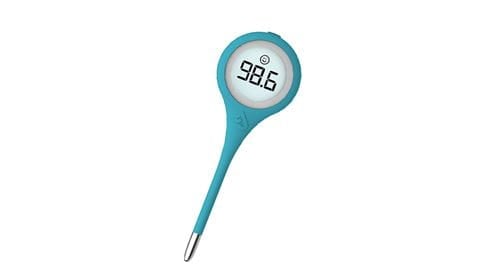
Kinsa Health smart thermometers employ nRF52810 System-on-Chip (SoC) to provide Bluetooth wireless connectivity to a paired smartphone app
The main method of lowering the infection rate and bringing an outbreak under control is to keep people apart so that the virus runs out of hosts. Governments around the world have implemented strict ‘lockdown’ regimes and then social distancing for the occasions when people do have to leave the safety of their homes. But even when everyone tries hard to abide by the rules, slip ups happen, and people pass close enough for the virus to take its chance. Bluetooth LE is at the heart of one technology being used to advise people if they’ve been unfortunate enough to pass close to someone who’s later tested positive for COVID-19 so they can arrange for their own test. The system is based on a cooperation between tech- giants Apple and Google and uses a Bluetooth LE service together with an app for detecting smartphone proximity.
Such technology is valuable but does have a drawback: While the virus doesn’t discriminate, the technology requires the services of an expensive smartphone, which is beyond much of the world’s population. An alternative that still takes advantage of proximity measurement through Bluetooth LE, but costs a lot less than a smartphone, is a wearable. One example has been developed by Spanish engineering company, Accent Systems; the Covid-19 BLE wristband is uniquely identifiable and uses Bluetooth LE to detect and record the user ID of every other wristband that it comes near over a 30-day period. If a wearer later develops COVID-19 symptoms, their data is automatically downloaded at a medical center so everyone they have come into contact with can be advised.
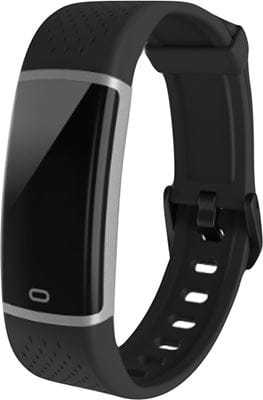
The 'Covid-19 BLE wristband' from Accent Systems, based on nRF52832
One challenge with contact tracing devices is that some perceive them to be an infringement on civil liberties. This perhaps explains the reticence of many to use government-mandated smartphone contact tracing apps.
In Australia, for example, after a big publicity campaign only four million people had downloaded the contact tracing app several weeks after its launch. The Australian government said at least ten million (40 percent of the population) need to download the app for contact tracing to work.
Companies are aware of the privacy concerns and have issued statements to reassure the public. Apple and Google say “user privacy and security [are] central to the design” of their technology and Accent Systems CEO, Jordi Casamada noted: “Only authorized authorities can access the [wristband] data, and only when required. Otherwise the whole system is completely anonymous and collected data [is] automatically deleted after 15 to 30 days.”
Life on the front line
Suffering from COVID-19 is no fun for anyone, but for some the suffering is easier to bear. SARS-CoV-2 seems to hit the elderly the hardest followed by those of any age who are unfortunate enough to suffer from co- morbidities. Meanwhile, younger, healthy people seem only to be troubled by little more than a raised temperature.
But it’s not always true that mild symptoms at the beginning of the illness will signal the same throughout. British Prime Minister Boris Johnson, for example, a healthy 55-year-old, contracted COVID-19 and spent ten days at home with few problems, before his condition deteriorated rapidly, and he was admitted to a hospital intensive care unit requiring specialist treatment including oxygen. And what happened to Johnson has affected others.
According to National Geographic magazine, one nasty aspect of SARS-CoV-2 is that it while it causes the oxygen saturation of the blood to dive, patients don’t feel breathless. That’s different to other respiratory diseases. As an example, the magazine reported that one COVID-19 patient in Oslo, Norway was talking and smiling, but his blue lips told another story, an oxygen saturation of 66 percent (compared with a normal level of 96 percent or greater) a level that causes major organ damage.
This gradual worsening of COVID-19 can get missed until a sudden collapse which then requires expensive and restricted hospital care. If the decline could be picked up earlier, less intensive therapy could be sufficient to arrest the disease and take pressure off hospital resources.
Pulse oximeters are one solution. These devices monitor the blood oxygen level such that the tell-tale signs of COVID-19 getting on top of a patient are indicated early.
Nordic customer Masimo’s Radius PPG pulse oximeter is a wireless device renowned for its accuracy, and, according to the company, is the preferred choice in nine out of the top ten hospitals in the U.S. The pulse oximeter is wirelessly connected to a patient’s smartphone which reports blood oxygen levels to a Cloud server. In this way medical staff can manage large numbers of patients remotely.
“We didn’t originally develop Radius PPG to combat COVID-19,” says Bilal Muhsin, Chief Operating Officer of Masimo. “But it turns out that in the current crisis this wireless capability, when paired with a secure, Cloud-based telehealth platform ... can provide a valuable way to manage COVID-19 patients who do not require hospitalization.”
Home monitoring with pulse oximeters and smart thermometers relieves pressure on health services, allowing them to focus on the thousands who are hospitalized, but that means doctors, nurses and support staff must put their own safety at risk to help the sick. Social distancing is not an option when tending a patient and faith is put in personal protection equipment (PPE) such as gloves, masks, gowns and goggles.
The supply of PPE has been compromised by high demand, not just from hospitals but also from the public keen to protect themselves. Yet medical staff need PPE more than others because when treating victims, the virus is ever-present. The gloves and masks offering protection while handling patients must be immediately discarded after the examination to avoid cross-contaminating anyone else. While industry has responded to shortages by repurposing machines to manufacture desperately needed PPE, there is still pressure on stocks. Nordic customer Cleanbox Technology has taken repurposing a step further to save precious supplies. The company has adapted its VR headset cleaner to sterilize worn masks so they can be reused. As part of the process the company’s CX1 system employs UV light and super-hydrophobic nanotech coatings that repel fluids and prevent them from seeping into masks, as well as an air system that removes detritus and any wetness remaining at the surface of the mask. The 60-second cleaning and drying cycle eliminates bacteria, viruses and fungi. Nordic Bluetooth LE connectivity makes it easy for technicians to configure the machine for extended cleaning cycles or longer air bursts, for example.
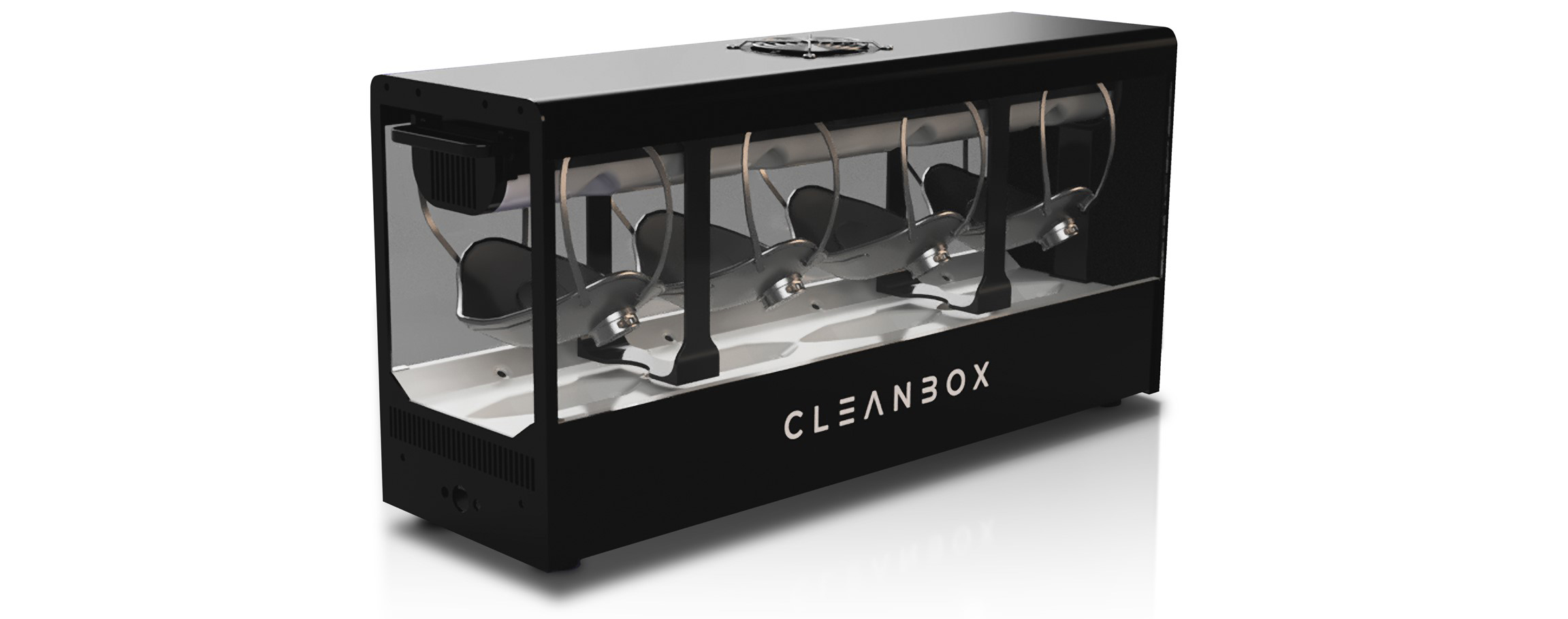
Cleanbox Technology has re-engineered its VR headset cleaner to sterilize multiple medical masks for reuse
“[The machine enables] continuous cleaning throughout the day ... without the use of chemicals,” explains Amy Hedrick, CEO of Cleanbox Technology.
Discarding PPE to avoid cross-contamination means there are times when medical staff are without gloves. It only takes the droplets from a patient’s sneeze to alight on a door handle, a light switch or a pen and the virus ends up on medical staff’s hands, just a touch of the face away from infection. The solution is systematic handwashing - soap or the alcohol in hand sanitizer breaks down the protein coat of the virus, rendering it harmless.
Doctors and nurses can be so busy coping with the number of patients that handwashing can be forgotten. “Before COVID-19 ... healthcare workers saw [hand hygiene] more as a task that ‘just had to be done’,” says Dr. Marco Bo Hansen, Medical Director of Sani nudge, a Danish healthcare company. “Now in the eye of the hurricane hand hygiene compliance is at the top of the quality list.”
The company has developed Bluetooth LE sensors which are attached to sanitizer dispensers to detect when staff use them. In addition, staff wear a tag which determines how often they use a sanitizer or other handwashing facilities. Sensors are also fitted above patient beds so that staff contact with them can be precisely monitored. A smartphone app summarizes the data so users can quickly see if their hygiene regime is satisfactory.
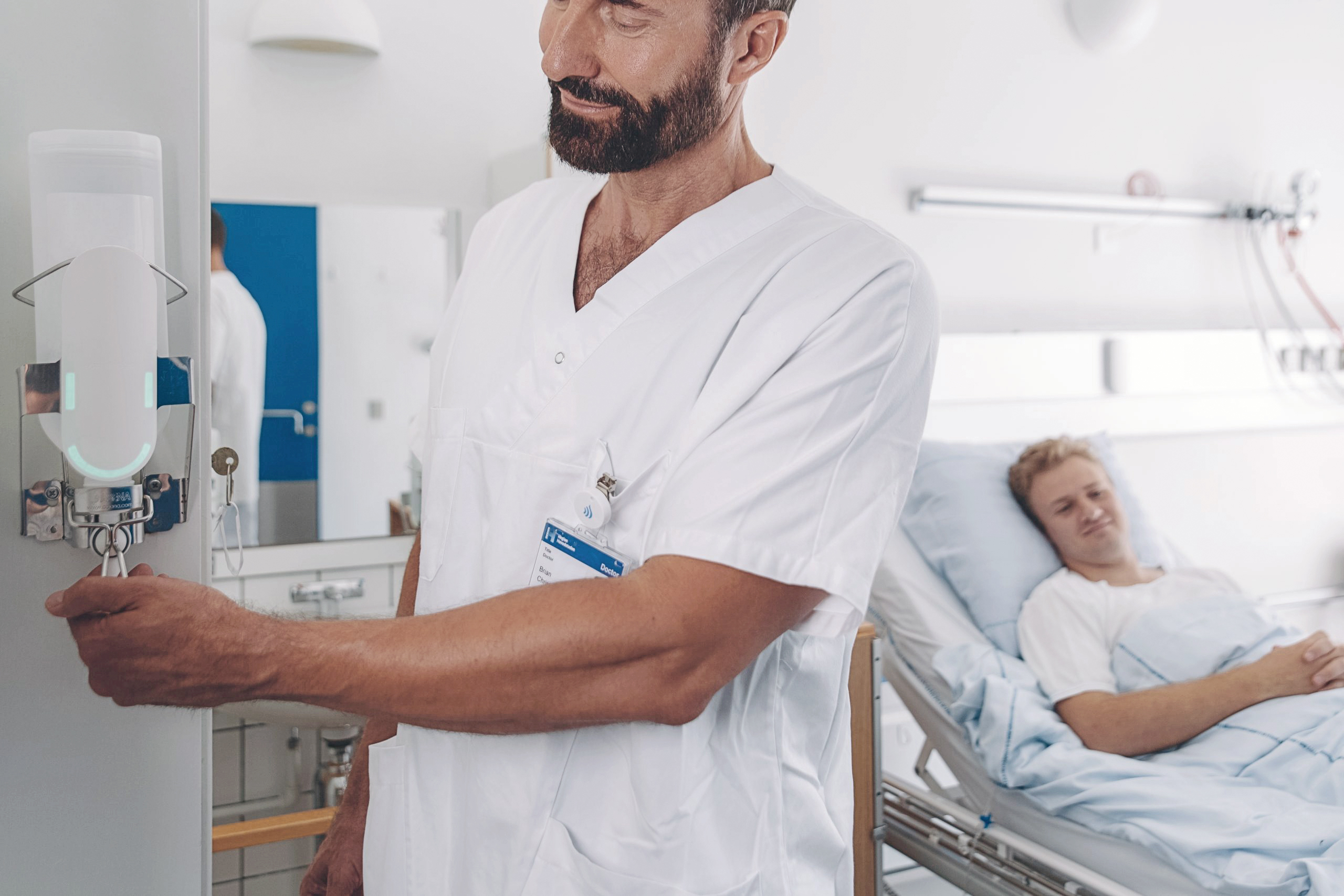
Sani nudge uses staff-worn Bluetooth LE tags and sensors attached to hand sanitizer dispensers to track hand hygiene compliance
Leaving the trenches
The problem with lockdowns is that while they help ‘flatten the curve’ of outbreaks they put people out of work and pull the rug from under economies. During the course of the pandemic, the U.S.’s unemployment rate is set to peak at a staggering 25 percent. Elsewhere, the U.K.’s economic output has contracted by a crippling 35 percent so far; added to the costs of supporting workers and tax cuts for business to help them stay afloat, such a contraction could see even the world’s sixth largest economy in trouble unless restrictions are eased. And the U.K. is far from alone. In the absence of a vaccine but with restrictions eased, technology will become even more important. “Even as lockdowns are eased and workers return, COVID-19 will remain a risk factor for some time,” explains Geir Langeland, Nordic’s Director of Sales & Marketing. “Technology is needed to enforce social distancing even when workers are distracted, along with rapid contact tracing should someone contract the virus. Bluetooth LE wearables are emerging as one of the most promising workplace solutions.”
Nordic customer Estimote has introduced a range of workplace safety contract tracing wearables. The wearables are worn by everyone within a specific work location, and if one worker is unfortunate enough to develop COVID-19, this data can be used to identify which employees may have been exposed to the virus and— crucially—the exposure time and thus the risk of infection. While contact tracing wearables for public use trigger notification but can’t determine positional information, an employer using the Estimote system can add reference- location Bluetooth beacons around the premises to determine where the infected person had been working and target that area for extra cleaning.
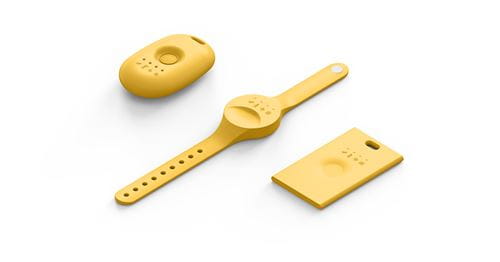
Estimote’s workplace safety wearables were designed to protect essential workers during the pandemic
PHYTEC, a German technology company is generating positional information in a different way by combining Nordic Bluetooth LE with ultra wideband (UWB), a short range wireless technology. Bluetooth LE is used to determine proximity while UWB determines exactly how close people have approached.
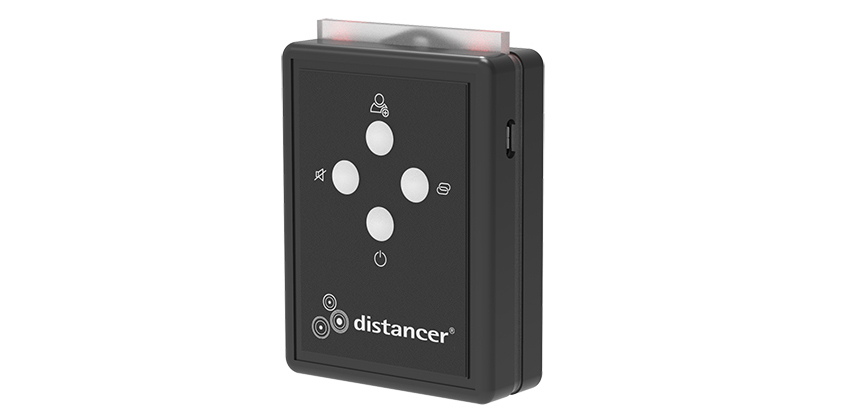
PHYTEC’s social distancing tracker enables face-to- face separation measurements within 5-10 cm accuracy
Such precision allows an alarm to sound if a person moves into the 1.5 meter danger zone where the risk of infection dramatically escalates. Precise distance information is also useful in deciding who needs to be tested; for example, moving within three meters of an infected person is considerably less risky than being within two meters.
Hygiene will be just as vital in workplaces as it currently is in hospitals. While people already wash their hands frequently, dealing with coronavirus contamination requires a greater level of care to ensure no trace of the virus remains. WashSense, a U.S.-based Nordic customer, has developed an easy-to-fit monitor that ensures good hand washing. Mounted above existing wall-mounted soap dispensers, the battery-powered WashSense includes an e-paper screen that activates once a user pushes the soap dispenser. Using thermal sensors, it is then able to monitor how well an individual is washing their hands.
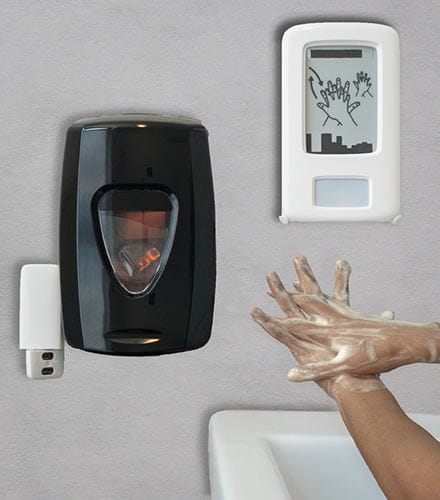
Washsense’s monitor uses thermal sensors to assess how well individuals wash their hands
When the battle is won
As successive governments relax lockdowns and things return to normal, it won’t be the same as before the pandemic. Even if a vaccine appears it will take years for it to have a global impact. As such, the good fight against SARS-CoV-2 still has a considerable time to run.
But the silver lining of this pandemic is its spur to innovation; not only will the tech developed to overcome coronavirus be vital for keeping it at bay it also lends itself to tackling other medical or non-medical problems.
For example, in its State Of Healthcare Q1’20 report, analyst CBInsights notes that telehealth usage has significantly accelerated during the pandemic and while its use is likely to recede when things calm down it will remain above pre-pandemic levels “as providers expand their offerings and as patients embrace the technology”.
The company also notes that key healthcare providers benefit from tech giants’ data and computing capabilities because the tech companies offer solutions that can be widely disseminated and scaled up in times of crisis. “In the future, this could impact how ... public health responses are orchestrated, with tech incumbents playing a large role in strategy and implementation.”
Unfortunately, scientists have identified no less than 31 coronaviruses in bats, and they are continuously mutating. That makes it highly likely that SARS-CoV-2 is not the last coronavirus pandemic we will see. But while this one may have caught us off guard, we can win the fight using technology in a way that’s never been done before. And next time we will be ready.